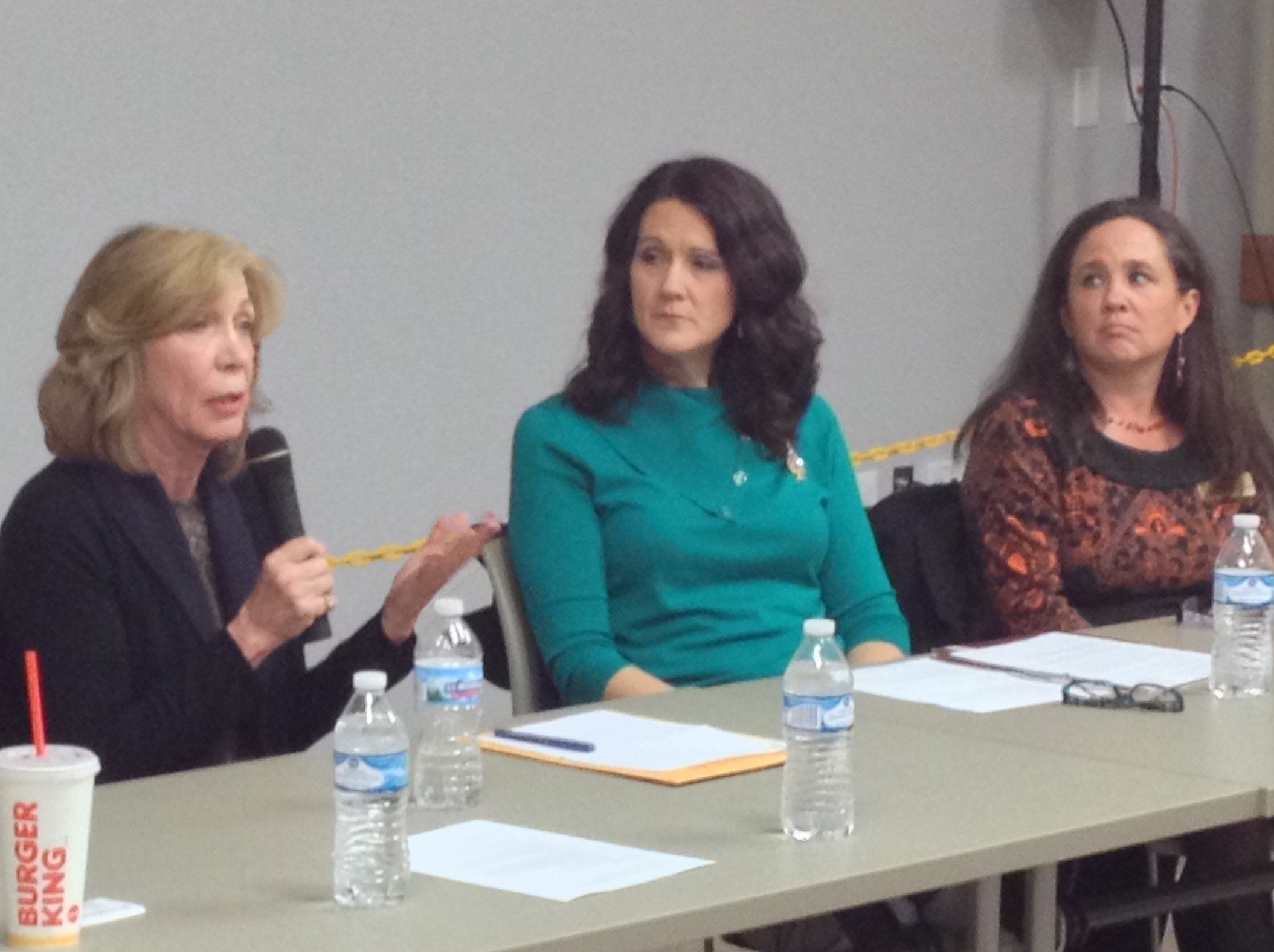By Mark Hansel
NKyTribune managing editor
More than 100 people filled the auditorium at the Kenton County Public Library Covington Branch Thursday for a discussion that focused on homelessness in the region.
The Northern Kentucky Forum presented Homelessness: Examining Causes, Finding Solutions, which focused on how homelessness is defined and what can be done to get people off the streets.
Marianne Scott, Human Services Specialist with the Northern Kentucky Area Development District (NKADD) provided an overview of the region’s homeless population. Scott said when speaking about homelessness, it is important to recognize how homelessness is defined.
The McKinney–Vento Homeless Assistance Act of 1987 helped identify some of the circumstances under which people could be recognized as homeless.

“It’s not just the type of homeless that we might think of as street homelessness or people that are homeless in shelters,” Scott said. “It also includes people who are precariously housed, doubled up in substandard housing, there are a lot of people who can fit under this definition.”
The definitions of homelessness used by the Department of Housing and Urban Development for distribution of its Continuum of Care (CofC) grants, however is much narrower. For example, people for whom a motel is their primary residence are not considered homeless.
The HUD definitions include people who are literally homeless or at imminent risk of homelessness, homes as a result of fleeing domestic violence or homeless under other federal laws. Northern Kentuckians are not eligible for CofC grants from the last category.
The K-Count, Kentucky’s Point-in-time homeless count, only recognizes people who are literally homeless, so it identifies one category in that narrower definition from a very transient population.
As a result, there is a consensus among those who provide assistance for the homeless that the statistics do not accurately reflect the scope of the problem.
According to the K-Count, 327 people were identified as homeless in the eight county Northern Kentucky region, which is down from 499 the previous year. That would seem to be a dramatic decrease, but in 2015 the five rural counties in the region did not identify any homeless during the count.
“If a child has to move, it takes up to six months for them to catch up academically. Sometimes within a school year a child moves three or four times,” Kelly Blevins, Kenton County School District
The Northern Kentucky Forum, a partnership of the Skyward, Legacy and NKU’s Scripps Howard Center for Civic Engagement, hosts discussions about important issues that impact the region’s communities.
The forum included representatives from some of the organizations that help address the region’s homeless problem, who outlined how their agencies contribute.
Linda Young, executive director of Welcome House, said the average length of stay at its shelter is 34 days.
“Shelter is really the tip of the iceberg in our experience,” Young said. “By the time they have come to us, they have already moved around, they have doubled up, they have tried to access every possible support that they have and they have run out of options. They usually have all of their possessions in one or two garbage bags.”
This makes it even more difficult to emerge from homelessness because the clients they serve are starting out with nothing.
The Welcome House shelter provides a continuum of services for women and children who are homeless or at risk of homelessness in a dormitory setting.
Young said the homeless problem in Northern Kentucky, is largely an economic issue.
“When you look at the folks that we serve, most all of them earn between minimum wage and$12 or $13 an hour,” Young said. “In order to rent a market-rate two-bedroom in Northern Kentucky, you have to be earning $14.46 an hour. So you don’t have to be a math wiz to figure out there is not enough money coming in to support a family.”
 This also helps dispel the myth that homeless people are primarily unemployed. Many who seek assistance do work, Young said, they just don’t make enough money to maintain a household.
This also helps dispel the myth that homeless people are primarily unemployed. Many who seek assistance do work, Young said, they just don’t make enough money to maintain a household.
Kim Webb is executive director of the Emergency Shelter of Northern Kentucky, which serves adult men and women who are 18 or older. It is the only emergency shelter of Northern Kentucky.
The Shelter is primarily known as a facility that provides emergency respite during the winter months, but it also provides shelter, including a shower/laundry program, three times a week in the summer.
“Last winter had us seeing 477 individuals from November 1 through March 31, give or take, based on temperatures,” Webb said. “Our average age was 44 years old and our average stay was 17 days, which kind of ties into the affordable housing. These individuals come to us facing a crisis in their lives that they probably never anticipated.”
The Emergency Shelter of Northern Kentucky is the only facility in the region that is handicapped-accessible and provides shelter for those actively addicted.
Kelly Blevins, court liaison and homeless education counselor for the Kenton County School District oversees services for the fourth largest district in the state of Kentucky. It includes three independent school district and its buses drive more than 10,000 miles a day.
“There are a lot of obstacles for families when their children are moving around frequently,” Blevins said.
Transiency, which is not included in most definitions of homelessness, can be just as big an obstacle when it comes to of education.
“One of the most important things is maintaining children in their schools of origin,” Blevins said. “If a child has to move, it takes up to six months for them to catch up academically. Sometimes within a school year a child moves three or four times.”
Every building within the Kenton County School District has a family resource coordinator that acts as a liaison for the more than 13,000 students that move frequently.
While there are some resources within the region to assist the homeless, the speakers agreed that it is difficult to provide adequate services without a broader definition that ensures access to help for more people.
The NKADD has worked to address the problem by providing sub-grants to direct service providers. It chooses providers who specialize in certain areas, such as domestic violence, disabilities or substance abuse treatment.
The next Northern Kentucky Forum event is A Look Ahead at the 2016 General Assembly, the annual discussion of the upcoming state legislative session. The event will take place January 6, at the Campbell County Fiscal Court Chambers. For more information, click here
Contact Mark Hansel at mark.hansel@nkytribune.com

















